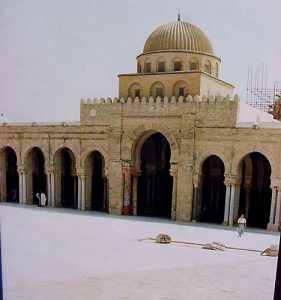
Islamic History: the Dome of the Rock mosque, Jerusalem
Before the Islamic Empire
In 600 AD, West Asia had been divided for centuries between two big empires, the Romans and the Sassanians. People probably thought that would continue more or less forever. But they were wrong. Both the Romans and the Sassanians had gotten in the habit of using mercenary soldiers from the Arabian Peninsula to fight their battles.
The Roman Empire
The Sassanians
Later Islamic history
All our Islamic Empire articles
The Ma’rib dam and Mohammed
In the 500s AD, Yemen’s great Ma’rib dam collapsed, ruining the irrigation system there. In the 600s, the Arab soldiers formed an army under their leader Mohammed and the new religion of Islam and unified the Arabian Peninsula. Under Mohammed’s successors, the Umayyad Caliphs, this army left the Arabian Peninsula. They attacked first the Romans and then the Sassanians.
Early Arabia
Who was Mohammed?
The religion of Islam
And the Umayyads

Kairouan’s prayer hall
The Islamic Empire expands
By 640 the Arabs controlled most of West Asia. Soon after that, under the rule of the Umayyad caliphs, they conquered Egypt. By 711 AD, the Umayyads controlled all of West Asia except Turkey (which was still part of the Roman Empire), and all of the southern Mediterranean: Egypt, Libya, Tunisia, Algeria, Morocco, and most of Spain. Soon they added Pakistan and Afghanistan.
Islamic Spain
The Sogdians in Central Asia
The Roman Empire continues
Charles Martel
History of Tibet
T’ang Dynasty China
In 732, an Arab army invaded southern France, but the French ruler Charles Martel turned them back at the Battle of Poitiers, and killed their general. Nearly twenty years later, in 751, the Arab army (with their ally Tibet) attacked China, at the opposite end of Asia, but the T’ang Dynasty Chinese army turned the Arab army back at the Battle of Talas.

Orange tree
The Silk Road

Egyptian knitted sock (ca. 1000 AD)
Still, by the middle of the 700s AD, the Islamic Empire covered most of the Mediterranean coast and West Asia, and part of Central Asia. Thanks to the Silk Road trade that went through their empire, connecting China, Central Asia, and India with East Africa and Europe, the Islamic Empire was powerful and wealthy. Manufacturers used knitting and then spinning wheels to make more clothing faster. They made mold-blown glass and steel. Ships crossed the Indian Ocean. They went down the coast of East Africa and east to Indonesia and China.
The Silk Road
History of cotton
Sugar in the Islamic Empire
History of knitting
Who invented the spinning wheel?
History of steel
New crops – cotton, sugar, lemons – were also helping the Islamic Empire’s economy. People must have thought that the Islamic Empire, too, would last a long time. But the Turks and Mongols of Central Asia had different ideas.
Learn by doing: a day in the Islamic Empire
Late Medieval Islam
More Islamic History
Bibliography and further reading about the Islamic Empire: